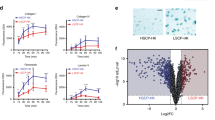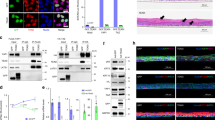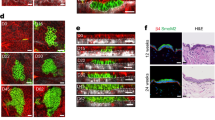Abstract
Transgenic mouse models have provided evidence that activation of the zinc-finger transcription factor GLI1 by Hedgehog (Hh)-signalling is a key step in the initiation of the tumorigenic programme leading to Basal Cell Carcinoma (BCC). However, the downstream events underlying Hh/GLI-induced BCC development are still obscure. Using in vitro model systems to analyse the effect of Hh/GLI-signalling in human keratinocytes, we identified a positive feedback mechanism involving the zinc finger transcription factors GLI1 and GLI2. Expression of GLI1 in human keratinocytes induced the transcriptional activator isoforms GLI2α and GLI2β. Both isoforms were also shown to be expressed at elevated levels in 21 BCCs compared to normal skin. Detailed time course experiments monitoring the transcriptional response of keratinocytes either to GLI1 or to GLI2 suggest that GLI1 is a direct target of GLI2, while activation of GLI2 by GLI1 is likely to be indirect. Furthermore, expression of either GLI2 or GLI1 led to an increase in DNA-synthesis in confluent human keratinocytes. Taken together, these results suggest an important role of the positive GLI1-GLI2 feedback loop in Hh-mediated epidermal cell proliferation.
This is a preview of subscription content, access via your institution
Access options
Subscribe to this journal
Receive 50 print issues and online access
$259.00 per year
only $5.18 per issue
Buy this article
- Purchase on Springer Link
- Instant access to full article PDF
Prices may be subject to local taxes which are calculated during checkout




Similar content being viewed by others
References
Altaba AR . 1999 Development 126: 3205–3216
Aszterbaum M, Epstein J, Oro A, Douglas V, LeBoit PE, Scott MP, Epstein Jr EH . 1999 Nat. Med. 5: 1285–1291
Aza-Blanc P, Lin HY, Ruiz i Altaba A, Kornberg TB . 2000 Development 127: 4293–4301
Bai CB, Joyner AL . 2001 Development 128: 5161–5172
Bonifas JM, Pennypacker S, Chuang PT, McMahon AP, Williams M, Rosenthal A, De Sauvage FJ, Epstein Jr EH . 2001 J. Invest. Dermatol. 116: 739–742
Boukamp P, Petrussevska RT, Breitkreutz D, Hornung J, Markham A, Fusenig NE . 1988 J. Cell. Biol. 106: 761–771
Dahmane N, Lee J, Robins P, Heller P, Ruiz i Altaba A . 1997 Nature 389: 876–881
Dahmane N, Sanchez P, Gitton Y, Palma V, Sun T, Beyna M, Weiner H, Ruiz i Altaba A . 2001 Development 128: 5201–5212
Dai P, Akimaru H, Tanaka Y, Maekawa T, Nakafuku M, Ishii S . 1999 J. Biol. Chem. 274: 8143–8152
Deng H, Lin Q, Khavari PA . 1997 Nat. Biotechnol. 15: 1388–1391
Ding Q, Motoyama J, Gasca S, Mo R, Sasaki H, Rossant J, Hui CC . 1998 Development 125: 2533–2543
Fan H, Khavari PA . 1999 J. Cell. Biol. 147: 71–76
Fan H, Oro AE, Scott MP, Khavari PA . 1997 Nat. Med. 3: 788–792
Gailani MR, Stahle-Backdahl M, Leffell DJ, Glynn M, Zaphiropoulos PG, Pressman C, Unden AB, Dean M, Brash DE, Bale AE, Toftgard R . 1996 Nat. Genet. 14: 78–81
Ghali L, Wong ST, Green J, Tidman N, Quinn AG . 1999 J. Invest. Dermatol. 113: 595–599
Goodrich LV, Scott MP . 1998 Neuron 21: 1243–1257
Grachtchouk M, Mo R, Yu S, Zhang X, Sasaki H, Hui CC, Dlugosz AA . 2000 Nat. Genet. 24: 216–217
Green J, Leigh IM, Poulsom R, Quinn AG . 1998 Br. J. Dermatol. 139: 911–915
Hahn H, Christiansen J, Wicking C, Zaphiropoulos PG, Chidambaram A, Gerrard B, Vorechovsky I, Bale AE, Toftgard R, Dean M, Wainwright B . 1996 J. Biol. Chem. 271: 12125–12128
Hahn H, Wojnowski L, Miller G, Zimmer A . 1999 J. Mol. Med. 77: 459–468
Hardcastle Z, Mo R, Hui CC, Sharpe PT . 1998 Development 125: 2803–2811
Hynes M, Stone DM, Dowd M, Pitts-Meek S, Goddard A, Gurney A, Rosenthal A . 1997 Neuron 19: 15–26
i Altaba AR . 1998 Development 125: 2203–2212
Ingham PW . 1998 EMBO J. 17: 3505–3511
Johnson RL, Rothman AL, Xie J, Goodrich LV, Bare JW, Bonifas JM, Quinn AG, Myers RM, Cox DR, Epstein Jr EH, Scott MP . 1996 Science 272: 1668–1671
Kinto N, Iwamoto M, Enomoto-Iwamoto M, Noji S, Ohuchi H, Yoshioka H, Kataoka H, Wada Y, Yuhao G, Takahashi HE, Yoshiki S, Yamaguchi A . 1997 FEBS. Lett. 404: 319–323
Kinzler KW, Bigner SH, Bigner DD, Trent JM, Law ML, O'Brien SJ, Wong AJ, Vogelstein B . 1987 Science 236: 70–73
Liu CZ, Yang JT, Yoon JW, Villavicencio E, Pfendler K, Walterhouse D, Iannaccone P . 1998 Gene 209: 1–11
Martin KJ, Graner E, Li Y, Price LM, Kritzman BM, Fournier MV, Rhei E, Pardee AB . 2001 Proc. Natl. Acad. Sci. USA 98: 2646–2651
Matise MP, Epstein DJ, Park HL, Platt KA, Joyner AL . 1998 Development 125: 2759–2770
Matise MP, Joyner AL . 1999 Oncogene 18: 7852–7859
Mo R, Freer AM, Zinyk DL, Crackower MA, Michaud J, Heng HH, Chik KW, Shi XM, Tsui LC, Cheng SH, Joyner AL, Hui C . 1997 Development 124: 113–123
Motoyama J, Liu J, Mo R, Ding Q, Post M, Hui CC . 1998 Nat. Genet. 20: 54–57
Mullor JL, Dahmane N, Sun T, Ruiz i Altaba A . 2001 Curr. Biol. 11: 769–773
Murone M, Rosenthal A, de Sauvage FJ . 1999 Curr. Biol. 9: 76–84
Nilsson M, Unden AB, Krause D, Malmqwist U, Raza K, Zaphiropoulos PG, Toftgard R . 2000 Proc. Natl. Acad. Sci. USA 97: 3438–3443
Oro AE, Higgins KM, Hu Z, Bonifas JM, Epstein Jr EH, Scott MP . 1997 Science 276: 817–821
Park HL, Bai C, Platt KA, Matise MP, Beeghly A, Hui CC, Nakashima M, Joyner AL . 2000 Development 127: 1593–1605
Rheinwald JG, Green H . 1975 Cell 6: 331–343
Ruiz i Altaba A . 1999 Trends Genet. 15: 418–425
Ruppert JM, Kinzler KW, Wong AJ, Bigner SH, Kao FT, Law ML, Seuanez HN, O'Brien SJ, Vogelstein B . 1988 Mol. Cell. Biol. 8: 3104–3113
Ruppert JM, Vogelstein B, Kinzler KW . 1991 Mol. Cell. Biol. 11: 1724–1728
Sasaki H, Nishizaki Y, Hui C, Nakafuku M, Kondoh H . 1999 Development 126: 3915–3924
Shin SH, Kogerman P, Lindstrom E, Toftgard R, Biesecker LG . 1999 Proc. Natl. Acad. Sci. USA 96: 2880–2884
Tanimura A, Dan S, Yoshida M . 1998 J. Virol. 72: 3958–3964
Toftgard R . 2000 Cell Mol. Life Sci. 57: 1720–1731
Villavicencio EH, Walterhouse DO, Iannaccone PM . 2000 Am. J. Hum. Genet. 67: 1047–1054
Xie J, Murone M, Luoh SM, Ryan A, Gu Q, Zhang C, Bonifas JM, Lam CW, Hynes M, Goddard A, Rosenthal A, Epstein Jr EH, de Sauvage FJ . 1998 Nature 391: 90–92
Acknowledgements
We thank Dr Ken Kinzler for the gift of GLI1 plasmid, Dr Paul Khavari for Sin-IP-GFP plasmid, Dr David Markovitz for providing human GLI2β expression plasmid, Dr Gary Nolan for the permission to use the Phoenix packaging cell line and Dr Norbert Fusenig for providing the HaCaT cell line. We are particularly grateful to Dr Harald Esterbauer for his advice and discussions about real-time PCR analysis and to Dr Emberger for histopathological analysis of BCC samples. This work was supported by FWF grant P14227-MOB (Austria), and the Medical Research Council (UK).
Author information
Authors and Affiliations
Corresponding author
Rights and permissions
About this article
Cite this article
Regl, G., Neill, G., Eichberger, T. et al. Human GLI2 and GLI1 are part of a positive feedback mechanism in Basal Cell Carcinoma. Oncogene 21, 5529–5539 (2002). https://doi.org/10.1038/sj.onc.1205748
Received:
Revised:
Accepted:
Issue Date:
DOI: https://doi.org/10.1038/sj.onc.1205748
Keywords
This article is cited by
-
The smoothened agonist SAG reduces mitochondrial dysfunction and neurotoxicity of frataxin-deficient astrocytes
Journal of Neuroinflammation (2022)
-
Associations of keratinocyte cancers with snp variants in the sonic hedgehog pathway
BMC Cancer (2022)
-
ABT-737 suppresses aberrant Hedgehog pathway and overcomes resistance to smoothened antagonists by blocking Gli
Medical Oncology (2022)
-
Expression of Sonic Hedgehog and pathway components in the embryonic mouse head: anatomical relationships between regulators of positive and negative feedback
BMC Research Notes (2021)
-
Exploring Sonic Hedgehog Cell Signaling in Neurogenesis: Its Potential Role in Depressive Behavior
Neurochemical Research (2021)



